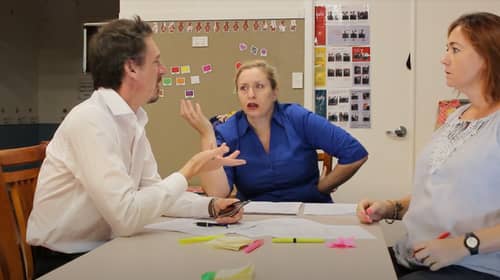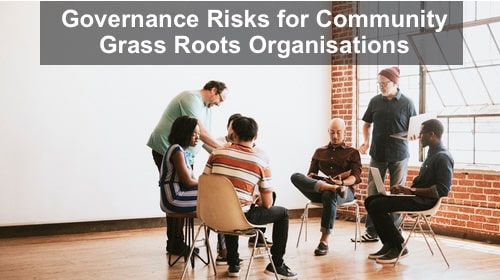Changing Your Constitution
Authored by:
iClick2Learn Team
Translate Text
Greetings everyone, I’m Dominic Cudmore.
Happy to answer any questions. Here are my contact details: dcudmore@hart-advisory.com or +61 434 879 138
Model Rules/Constitutions for incorporated associations across Australia
ACT: https://www.legislation.act.
NT: https://nt.gov.au/industry/
TAS: https://www.legislation.tas.
WA: https://www.commerce.wa.gov.
ACNC Template Constitution for a Charitable Company Limited by Guarantee https://www.acnc.gov.au/tools/
ACNC Charity Register search https://www.acnc.gov.au/
Hello, hello. Welcome, welcome. It’s so fabulous to have you here with us today. My name is Natalie Bramble, if I haven’t spoken to her already, I can see some familiar names for those that are joining us. It’s so great to have our members present and with us today, and I wanted to introduce you to the wonderful Dominic Cudmore.
– Thanks Nat. Welcome everybody.
– So I would love to introduce and give you some background on Dominic. Dominic has actually been an avid supporter of iClick2Learn for maybe years. I think we’re probably going back about six years.
– I think so.
– Yeah, it’s about that. Dominic and I have worked on a few projects together, two big projects, namely in Western Australia and Queensland, and they’re around state-wide constitution, a template constitution for Western Australian legislative compliance project for Queensland, it’s around sport groups and fundraising. He has extensive experience in this field. And Dominic I’ll hand over you to give you a bit of background as well for some other areas that may be of interest for those joining us, Dominic.
– Thanks, Nat. Well, for those of you that may not know me, I’m a city based solicitor and I’ve been working as Nat said in the area of not-for-profits and charities for many years, not exclusively that. But advising not-for-profits and charities and principally in the fields of governance. So working on constitution and rules, converting constitutions from incorporated associations to companies, limited by guarantee. We’ll talk about that later. Tax status, DGR status and other sorts of tax beneficial statuses for not-for-profits. Definitions of charity or ACNC governance standards, all that sort of stuff, and also child protection, employment law, et cetera, specifically within your sector, the not-for-profit/charity sector.
– Wonderful.
– I’ll put my details in the chat there. If you want to contact me by phone or by email at any time, feel free.
– Wonderful. Thanks Dominic. Now I see we’ve had a few more joining us as well. So just as a recap, if you would like, as we go through today’s session to ask any question, please just ask it direct to me or pop it in the public chat. And we’ve also given you some handouts as well. So just some handouts of the key points that we’re talking about. I’ve just enabled public chat now, so you’ll be able to access that. So the handouts are just some key points we’re talking through today. And of course for our wonderful members, this will be up in the library in within 24 hours as well. So you’ll get an email letting you know. Excitingly Dominic’s also working on a category and working on some more contents. So if there’s anything in particular that has come to mind from today’s session that you think, oh, I wouldn’t mind knowing more about X. We’re always happy to build content for you. So please let us know. You can either contact Dominic directly, or you can email me, Natalie@iClick2Learn.com.au, and we’ll add that content to our content development to help you even further. So what we’re talking about today is essentially the process of changing the constitution, which covers reviewing what you’re already doing, having a really great discussion, getting consensus, drafting the rules and discussing them to the point of approval and getting a special resolution passed. Lodging rules and of course changing with your internal records. And so what we’re going to start with first is reviewing your existing rules. ‘Cause there’s a couple of things that you might really want to pay attention to. So Dominic reviewing existing rules, what are your top tips for everybody?
– Well, I think, and this is a general comment of at any organisation, even in the not-for-profit sector, even before you look at the constitution is decide what you’re on about. Well, what is your object? What is your mission? And I think getting that very clear from the get go is essential. And then the next step is to talk about these technical aspects of running your organisation. In Australia, the two main types of legal structures that are relevant to the not-for-profit sector are either an incorporated association, which is run under the law of your state or territory. The other most common form of structure is an Australian public company, limited by guarantee along title. That’s really just a not-for-profit company, and it’s registered by the Australian securities and investments commission and it’s national. So there’ll be a few things you’d need to think about, first of all, where do we operate? Are we operating in one state or territory? If so, maybe an incorporated association is fine. How big are we? Are we enormous? Are we small? The smaller you are, the more likely an incorporated association is. Or what plans do we have? Do we have plans to go big? Do we have plans to go into state or into territory? Do you have plans to go national? If that’s the case, then maybe the most appropriate structure is an Australian public company limited by guarantee. But as I said, the object of the mission of your organisation is central. And I’d encourage every not-for-profit organisation to focus on their mission before they start writing their constitution or get their constitution written for them. And also review the constitution regularly. It’s a living document, but the mission or the objects are essential. And if your organisation also wants charity status to get charity status with the Australian charities and not-for-profits commission, their guidelines will also be relevant to your objects and mission because you have to include specific words that will actually achieve the charitable status that you want.
– I just love that you started off with objects first. Dominic, it’s such an important point. And I know we’ve got a few people from New South Wales here. We’ve got quite a few people from different states and territories joining us. But for me, the New South Wales example is relevant. The model constitution doesn’t even have a place for where you put your objects too, which is really interesting. Because a lot of objects are actually critically important. And that defines what you are legally required to or permitted to do.
– Yes, it sets the whole parameter for your organisation. Says, what you are going to do, what the limits of the things you are going to do are, and also it will be what the Australian charities and not-for-profits commission looks at when reviewing your constitution to check that you fit within their guidelines. If you are aiming for charity status. So it’s very, very important. I should also point out that each state and territory has a set of model rules or a model constitution, the states and territories refer to the document in different language. So most states call it, rules, a couple of states, including New South Wales now call it a constitution or an incorporated association. I hope that makes sense. And I’m not confusing things. Whereas if you are a company a not for profit company, you will have a constitution as anyone would for it.
– Yeah. Great. Thanks, Dominic. And so important. I think if you’ve got an existing constitution. And look, I’ve seen them called terms of reference and objects and other unusual sort of terms. But in essence, it is a rule book and it’s a constitution, that’s the modern language for it. I’ve seen charities have those conversations. And so charities are those who do have that taxable status, deductible gift recipient, and they’re having conversations around reviewing their objects. And so another important point to reinforce Dominic, is that if you change your objects, that potentially could actually jeopardise your DGR status.
– Absolutely nice. The objects are not just an essential element for running your organisation, if you’re a charity, they’re also very, very relevant for your charitable status. So, take note, I suppose the word is not be cautious, but take into consideration your charity status whenever you are reviewing your objects. And you might get your advice on that too, because the reality is charity law. It looks simple when you first look at it, but it is not a simple thing. When I teach this, I teach at law school and I teach the subject of equity, which is charities are related to the law of equity. And we go back, some of the law relating to charitable status, goes back to a statute, passed under the reign of Elizabeth I.
– Wow, there you go.
– All right, a charity law has a long history. You don’t really want to know that history, but the point for me is that, when changing objects, if you have an endorsed status, check, be alert and maybe seek advice.
– Yeah, fantastic. And so we’d start with the objects. And I think another point here, in conversations to share as well. And Dominic, your thoughts is, there is often that, how prescriptive should we be in our objects? Will it actually create a potential barrier for an organisation to take advantage of an opportunity maybe if their objects are so prescriptive.
– Yeah, another good point Nat. The objects yes, best to avoid being too precise, I guess to stating they should be statements of purpose rather than activities. I’m trying to think of an example, but at the moment, one isn’t coming to mind. But be purposeful about the area of activity you want to operate in, but not too precise as to how you’re going to do it.
– That is such an excellent distinction. So focus, purpose in your objects, not activity. An example might be, if you’re a domestic violence support organisation, your purpose is to provide supports to those vulnerable people, not how you do that, which is, you provide for example, counselling and housing. So that would be an example.
– Absolutely. It could be, you might, restrict yourself to a region like providing housing assistance in the Launceston area in Tasmania. Notice how I pronounced that, Tasmania?
– Tasmania, we’ll be loving you for that.
– Or the Albany area in Victoria another brownie point. Whereas in fact, you might have plans to grow. So why restrict yourself to that area? You know, you might. Those words restrict. Any restriction, consider restrictions carefully because you may grow and may want to grow. And well you probably, growing is good. So yeah, too many prescriptions and too many limitations could be a problem. I mean, it can be fixed of course, by changing your constitution, but that will normally require a meeting of all of your members. And that can be a bit of a headache. So avoiding the need to change a constitution except for very big issues is probably a good idea.
– Brilliant. So the first thing that we would do when we’re looking at and reviewing a constitution is let’s start with our purpose. Let’s look at out objects and make sure they reflect purpose more than activities, unless for some reason you want those constraints or considerations in. And then I guess, whether you’re reviewing your existing constitution or you’re starting brand new, these are all great processes to follow or steps to follow. And Dominic, you mentioned sort of model rules or model constitution. And I’ll just give everybody a little visual on what this means. Under the act for which you’re incorporated under, there’s a thing called, for every act there’s a regulation. And the way I think about acts and regulations is it acts like a policy, but a regulation is like a procedure. A regulation helps you work out what you need to do. And that’s where the model rules or model constitution come from. That helps us really interpret. So we don’t have to be the brains of someone like Dominic to know the more we can actually use the regulations and use the model. And it gives us a flexibility. Doesn’t it Dominic? To make sure that we can either adopt our own constitution. So we could actually go to someone and have them actually write up out constitution, or we could actually adopt the model that’s being proposed either for the ACNC has a model constitution, every state and territory does as well. When we think about adopting the model, ’cause I’ve certainly noticed over time and we’ve had actually conversations about this as well on different constitutions we worked on where the model does actually, give a little bit of freedom in some areas we might not want, but it also potentially misses out on being quite prescriptive. Particularly around things like, for example, disciplining members.
– Absolutely, Nat. I mean there might be particular issues within an individual organisation that require specific provision. Well where a specific provision would help in your constitution. So for example, if you had an organisation, which is, I’ve been going for quite a while, and you have a concern about the turnover in your management committee, that there are a few people whose roots have grown too deep and who seem to almost own the organisation. Noting that not-for-profit organisations, they incorporated associations or companies are not owned by anybody, they’re owned by their mission. So no one owns it really, but you know, the reality of human life is, sometimes people who are very dedicated may have been there for 20 years, but in some cases may not be helping to take the organisation through that. So a way of dealing with that might be, to include a provision that says that, members of the management committee have three year terms, they’re renewable on two or three occasions or something like that. And after that, they can’t be renewed again. Or some specific provision that makes it clear. It’s sending a message that this is not an organisation that is owned by anybody. It is the mission that owns it.
– Yeah, that’s a fantastic example Dominic, and sort of reinforce that the model is really there to be helpful, but it doesn’t mean that you can’t change clauses and adapt them to suit your needs. I mean, I always say with any model is that if there’s any number you shouldn’t go below that number. That’s kind of a general rule of thumb, but otherwise, you can add and adapt things and we’ll talk a little bit more about that a little later.
– Can I add something there?
– All right.
– I also take real property law. Many of you may have bought up your house. Hopefully you like it here, if you’re in Sydney Sydney is a nightmare for buying houses, but anyhow, the standard contract, which is established by the law society, it’s got 1,000 clauses, but you can add your special conditions. And every contract has a special condition added. Because each story is different. Each purchase at a house is different. And you’ll want special things added. So I look at the model constitution or the model rules proposed by our state parliaments and territory parliaments as that they are an example that will work, but your organisation is special. Hopefully it is special, otherwise you wouldn’t be doing what you do. And so you will almost, every organisation will probably want to adapt it, to suit their specific needs.
– I love that. That’s such a good point. What about bylaws? What are bylaws, Dominic? If people are looking at, they’ve heard conversations, oh we’ve got bylaws, or they’re looking at some documents and they see bylaws, how do they play a part in this.
– Bylaws within associated with an association, Nat?
– Yeah.
– Now it they could be rules to do with subcommittees. You finance committee or the way your board operates. They’re guidance documents that are. What’s the word? But depend upon the constitution, overtake the constitution.
– Yeah. So one of the ways I used to talk about bylaws, is it’s like a policy document that members own, members have power approving or changing or modifying. And a perfect example I use. ‘Cause even if you’re not playing sport, you understand how sports competitions are so competitive. And so a lot of sporting organisations have bylaws that then provide very prescriptive rules around how people participate, the points awarded all that sort of thing to do with a competition. But the key thing is that those bylaws are deeply connected to the constitution. So the constitution will actually tell you how changes to those bylaws are permitted.
– View it like, it’s the same as in parliaments, we have an act of parliament, which is the principle legislation. And then there are regulations that may be also tabled that depend upon that name piece of legislation.
– Fantastic, so some of these bylaws may not even exist. They’re kind of a bit more of a historical or a member power document really out there. What are some value. And I’ll just make a note here that Dominic’s put some great links in the chat. If you can’t see those, just head to the public chat. And I’m just checking Q&A’s to see what is coming through. So please, if you’ve got any of these specific questions, please ask why. Dominic, what are some of the valuable things that you might gain by looking at constitutions of other similar organisations?
– Well, I think it’s always good to go, what’s the word? Scavenging around.
– I call that R&D rip off and duplicate. But not quite so duplicate.
– But yeah. Have a look at what other organisations in a similar field are doing. You might have a related organisation in another state or territory. They might’ve put a lot of work into their rules and their constitution and their bylaws. Have a look at what they’re doing. A lot of places are doing things extremely well and they might have the resources do it. They might be happy to share their resources with you, but as regards the constitution, yeah, look around and search around for some similar organisations and particularly in relation to their mission and objects, which I think is crucial, but also look at the other provisions in their constitution. And is that actually that could be very useful for our constitution. I think comparing is very, very, very useful. It’s not a real… Well actually I was about to say, there’s no central repository of constitutions, but in a sense there is. At least if you’re a company limited by guarantee and you’re registered as a charity, the ACNC stores, the rules or constitutions of that bodies. So you can do a search on the ACNC register and it shows who are the, what’s the term they use? The designated people, or anyhow, whoever the directors are it shows that. And then it shows their financial documents for each year, but also their constitution or rules. So they’re easily accessible for a public company registered with ACIC. Well, and also actually, if they’re an association registered with ACIC, they will be there as well. So the ICNC register could be a very good place to have a look, for the rules of an organisation similar to yours, yeah.
– Yeah, I’ve actually done that. I was working with an arts group and we were looking at fundraising and deductible gifts and yeah, exactly. That went to the ACNC’s charity register, which it looks like Dominic’s getting you the link for now. And we’ll in the library, we’ll put these links on the page as well. So they should be just down on the video. And yeah, we’ve looked for another similar ACNC organisations and we’ve looked at at their constitution and we’ve looked at the objects and had some discussions around there. So there can be definitely some value in doing that. From a process perspective, like how do we do this at a practical level? One of the things I found useful, and just clarifying when we use the board or committee or management committee, we’re talking about your governing group of people. We know there are different terms used in our sector and when we’re talking, he might use board and then you might use committee, but to simplify things, we just use the term sort of subcommittee to define a sub committee of a board or a sub-committee of the committee. So when we look at, who should do it, we often find that it’s, these kind of complex discussions at best, for a small group of people. So it may be something that you may want your, the three people who are going to be on a subcommittee, to go away and sort of have those conversations and then bring their thoughts back to the board or your committee. ‘Cause it can be a detailed area kind of maybe we could spend, a whole whole day. This could be Dominic, talking about constitution.
– Absolutely, absolutely. And also with subcommittees, you can establish subcommittees. Their authority comes from the board of your organisation, but they can have separate meetings to deal with issues. You might want to be looking for a new CEO. You could have a CEO search subcommittee or a personnel subcommittee, which goes away and even includes maybe one or two members of your board or committee. And it might include other people who are willing to be involved and they do their research and they come back with recommendations to the main board as to who they think should be appointed. Or a finance subcommittee, or even a constitutional change subcommittee. Doing the work away from the main board meeting. I realise for many of your organisations, you’re not that peer to be able to have, may not have enough people involved to do those sorts of things. But if you’re a larger organisation, it’s very common for work to be done outside board meetings by subcommittees. And again, the authority depends upon the constitution and that their authority depends upon the board. They can’t run off and do their own thing. And they can’t make decisions really, they make recommendations to the board to be accepted or rejected.
– Fantastic, so what’s next? One of the valuable things that I know that I found Dominic, is that, and it comes back to some of that similar points you made about purpose and objects, is having a conversation about where you want the organisation to be and what you want the organisation to be doing as much as talking about, there are a lot of sort of issues and challenges, that hopefully your organisation hasn’t had but certainly may have heard, other organisations, had these issues. And so reviewing your constitution is actually an opportunity to either, be the sorts of organisation you want to be, for example, if you want to be a charity and you’re not currently. Or to say, similarly I think the example you used earlier, Dominic, was around someone who wasn’t, had been there sort of too long. We’re not saying that, the longevity is a bad thing. It’s just more around usefulness, I think is the most appropriate thing. Some people that have been in a position a long time have what’s called, I call the founder syndrome and they want to hold onto everything. And this is the way it’s been done in the past and that it shall always be that way, but it’s–
– Okay, how dare you? How dare you could just tell lies. but it’s mindset that defines that, not necessarily longevity. So this is an opportunity, isn’t it, Dominic?
– Well, absolutely. It’ a good clarification in that. The fact that somebody has been there for 20 years is not in itself a problem. It could be a wonderful thing. I’m thinking of Catherine Hamlin who died a couple of years ago, the woman that set up the Fistula Foundation in Ethiopia, wonderful Australian woman. She’d been running this thing for a million years. I mean founders, they’ve got special gifts. And their gifts are often very, very valuable to the organisation, but there could be ways of acknowledging that, and having special status for this person without giving them necessarily a legal authority. Or you might decide you want them in the management committee or the board. So that’s perfectly fine, but it’s important to have a discussion about it, is it helping your organisation or not? Is it helping you in Michigan or not? And if it’s not, then it requires a discussion. And it should be depersonalised because it’s really not about an individual. It’s about, again, the mission of the organisation, not trying to hurt anybody, but you’re trying to take your organisation forward.
– And so there’s also some other. Again, making sure that, your purpose, your mission really guides these things like, you might want diversification around your membership. What about age limits, Dominic, this has always sort of been a question, that’s quite common around having people, that are under 18, either as a member. So two things, one is someone under 18, that’s a member of an association. And the second question is someone who’s under 18 as a committee or board member. ‘Cause you find me strive to bring on younger people. That’s, a common question.
– Yes, a good one there. I have an idea, I have an idea into that one. It’s never actually come up. I think you know the answer.
– Okay, here we go, okay.
– I’ve never actually, never been an issue. I mean having a diverse board and a diverse membership, of course, very, very important. Very valuable things in any, any organisation, diversity in all sorts of ways. Diversity genders, diversity of race. It’s Australia or after all. But, the age thing, I’ve never actually had to consider that one.
– Oh, we going to go. We’d like to do a separate little follow up on this one. But my understanding Dominic of that is that, members under 18 is perfectly fine. It’s not a problem at all, but once they take on some governing roles, then things come into play like the Minors Acting, et cetera. So the recommendations, sort of the many different sort of organisations, and legal experts we’ve worked with over time in different sort of projects I’ve done has been look at the baseline is that, 18 years and over for a board member or a director, but there’s nothing stopping you at all from having sort of so accommodative of younger people into the board where they’re engaged in decisions or even on subcommittees. So that’s something to consider.
– I work at a couple of universities in Sydney. And we’ve had students who doing pro bono legal work as part of their legal studies. Well, actually they haven’t been they’ve been guests at the senate meetings of the university senate. So giving young people experience at that is a wonderful way to get them ready to potentially, these are the young people who are interested in your organization’s mission to get them ready and interested in your organisation and offering ideas even before they have a formal role. So that could be very good. I think, as regards to the minor issue, for incorporated associations, it would depend on the legislation in each of your states and territories, but yes, generally, yeah that’s right. Generally you’d want somebody who’s an adult and not a minor.
– And we’ll talk a little bit more about, director’s nominations, cause there’s some other things that come into play there as well. There needs to be some minimum eligibility requirements for directors now, which over time, this has certainly changed. And certainly all states and territory acts as sort of following almost, some of the rules in the corporations act, which is an interesting one as well. And there’s an opportunity here, I think to take advantage of the constitution to define a rule. Because then you’re not, you’re not talking personally, you as the governing body, the board is not making a decision on something. Actually the constitution says, this is how it is. Because the constitution, I think one of the important things to reinforce is that this is a legal contract, Dominic, isn’t it? But if I’m a member of an organisation and I’m accepted as a member, and I’ve got a copy of the constitution, in effect what I’ve agreed to is a contractual relationship.
– In deed it is Nat, the law of contract says that. And the legislation in each state and territory and the federal legislation for companies. Is that the constitution is a contract between each member and the company and each member and other members. So can actually be enforced contractually. So yeah, does have legal force beyond the legislation establishing that brings it into the role of contract law. So it’s a serious document.
– And so a big tip here for everybody is on your membership application form. If you have one. If you don’t have a membership application form, you’ll find one in the library is a template there for you. And a big tip here for everybody is to make sure that those who apply to become members are fully informed about your current constitution, because they actually need to agree to those terms. And certainly the template has a notice that they do agree to those terms. And when it’s not in. So let’s just say that there’s been an issue and we go to the constitution and it’s not in the constitution. And let’s just say that I as a member, want to take this further, where might this situation end up because it hasn’t been defined in the constitution?
– Well, one of the possible consequences now is that they would need to be a change to the constitution, and that will require either it could be done at the annual general meeting, but more commonly, it would be done at a special general meeting, which is basically an annual general meeting, but not at a normal annual general meeting time. So you bring together your members and you get them to vote. And normally that would require a special majority to be approved, 75% of members to be approved. And if it’s approved by 75% of the members, then the constitution is generally changed. You notify the regulator, which for an incorporated association would be your state regulator, department of commerce, in NWA fair trading, and New South Wales fair trading in Queensland, whichever one it is in your state or territory, Or ACIC and the ACNC if you’re a charity. If you’re a company ACIC and ACNC as well as any sort of registered charity. So that would be an issue. It could well be that it might just require an interpretation of your constitution and doesn’t require a change, but you might need advice on that.
– Fantastic, so I’ve just had a question here, around the minimum eligibility requirements, and I know that this person is in Queensland. I’ll specifically state to Queensland, as well as other states. And so basically what has happened over time and Dominic and I’ve worked in well in different states, but also primarily, sort of WY Queensland’s to the states that we’ve worked collectively on. And I know that he’s worked broadly across Australia as well. There’s been a lot of shifts, so I’ll just give you some sort of background. There’s been a lot of shifts in constitutions for incorporated associations. And I think one of the examples in 2009 New South Wales had a complete overhaul of the model or their act I should say, and they constitution and I followed Victoria, Victoria was the first one to do it. And what I certainly saw reflected was a lot of, of the things from the corporations act and WY, which is a project we worked on specifically. Again now overhauled their associations incorporation’s act, and they introduced a lot of things that includes directors eligibility. Now, just speaking to Queensland, that is coming, there are some new laws being proposed for Queensland associations, incorporations, organisations. And Dominic, fantastic, you’ve provided a link for that as well. We’re all over the webinar, well I think, this is excellent. So there are some new laws being proposed around committee eligibility requirements. And I’ll send an email out to everybody with those links as well. And again, if you’re watching the recording, it’s down just under the video. So one of the other things I thought I’d share from a practical sense Dominic, that I know has helped me kind of get my head around, but also when I’m working with, either as a volunteer, when I’m helping support organisations is a bit of a table to help think through some of the clauses. Now for those listening in today, are unable to see the screen, I’m just going to do a visual descriptor of what we’re looking at. So we’re looking at a four column table. This is what I would call as an extract of an example. So there is a heading in the first column, it asks what clause we’re talking about. And there are two parts to that. Which is, what is the purpose of that clause, part A, and part B, what do we want to include? So this is about a membership fee clause. I’ve used a very simplified example. And so the purpose of this clause is to establish the membership that a membership fee is applicable. And the second part is to say that, if they don’t pay within a set timeframe, it needs to be really clear to them, that they’re not entitled to be a member to vote. And so to be clear here, B, is things that we want. So this is an example of where this is an opportunity for you to add these things into a constitution. So if we know that, we just want to make it clear to everyone. If you don’t pay your membership fee before a certain point in time, then you’re not eligible to vote in particularly for some organisations that voting is always a special general meeting or AGM, isn’t it Dominic?
– It is. And that’s very important too now for every not-for-profit organisation to have an up-to-date membership register. Because generally, you won’t really need it I suppose, except when you want to do something big like change your constitution. And then, I’ve seen so many organisations, that well, we’re not really up to date on member that Mary was a member, she’s been a member for years but we don’t know if she was renewed for the past three. Keeping your membership register up to date is really important because it becomes important when things become important. So to change something major, you need a really precise membership register and having a rule that says remember, the annual membership fee will be set at each AGM or whatever. And if you don’t pay your membership fee within a certain period of time, you are no longer a member. Rather than having to decide whether they’re a member or not, which basically it often will have no solution. But membership registers are so, so important, but not all the time. Well, they’re important to maintain well. They only become very important when you want to do something quite crucial and then they become headache if they’re not kept up to date.
– Yeah, definitely. That is such an important point. Thank you.
– Also with members I might add that, people need to be clear about who their members are there. They’re not just your supporters. They are the people that have signed up to be your members. So they’re not just your fan group. You might have a massive fan group, but it’d be great to have, you need to really bring them on as members to give them more authority ’cause they’re the ones that have the ultimate authority. They don’t run the board day-to-day, but they are the ones that make the big decisions. They can vote committee members on and off, and they can change the constitution. They can call special general meetings themselves. if the board decides it doesn’t want to or refuses to. So they have a lot of ultimate power. So that’s why that’s a very important register to keep really well.
– Fantastic, thanks Dominic. And so, the other columns in the table, basically just cutting and pasting that clause. So, it would have a headline in your constitution, in the model constitution, and we’ve done exactly that. We’ve grabbed a similar organisations constitution and we’ve had a look at those three clauses. And so, basically we just cut and paste those clauses in the table and it just helps guide some discussion. I mean, obviously if you are changing anything it is important, Dominic, isn’t it? To make sure that it is legally compliant and it’s not actually contradicting or excluding particular provisions that you have to have in a constitution.
– Absolutely not. The legislation that applies to your organisation will say what has to be included. That’s probably a very long list that it will say the things that must be included. The model constitutions or the model rules will include the essential things, that they might include a few other things. The other things are optional and you may want them and they’ve had a lot of thinking put into them. The government lawyers have written these things and they’re pretty good at writing these things. They’re very helpful as guidance, but they do not limit you. You can also go hardball on some of these things if you want to. They refer to this model constitution or model rules they’re designed to it’s a one size fits all. So they’re not going to be very specific. So if you want to go specific, go specific. And I like this idea of comparing the current version to the model version and to a similar organisation and doing some brainstorming about what you want in your constitution.
– Fantastic. So that’s something that everybody could use. And even if you do get someone involved to help you make sure that it’s legally compliant to for example, if I went to Dominic, of course, this sort of thinking actually helps inform the work that they’re doing for you. And I’ve had many of a time where I’ve sort of spoken to people who really aren’t sort of Dominic sort of works in the sector. And fortunately it’s not Dominic, but we’ve had some conversations with our lawyers that aren’t familiar with the sector and I express things. I’m like, yeah but that’s, hang on, how does that actually work in practise? ‘Cause if it doesn’t work in practise, we need to make sure that the clause is worded so that its plan unleash, but it actually helps people and that you can actually do that. Because the minute it creates a barrier, rules should be put in place of course, but ultimately it’s about enabling the work we do. So these sort of document, if you did this and you brainstorm what those things are, that’s only going to help you at the point of when you wanting to look at a constitution. And we might have a further webinar on the model, choosing a state’s model constitution and talking through that and having a discussion about particular clauses and things that you might want to look out for. So that is as an example for you that you can use to work through. We’re going really well, we’ve got about 10 minutes left I think almost. I’m just going to check questions. If there’s any further questions, feel free to answer those. We might pick up on a couple more things in this next slide, Dominic. So these are just some of the causes that you might be looking at. I think we’ve talked about some of those clauses. I’ll probably put a note on members disputes, pretty much the members dispute causes that are in models, I would certainly say you should be just adopting those. You might want to add some extra things around process but as Dominic said, there’s a lot of government lawyers that have spent a lot of time on this. And it is around that equity piece to make sure that members are treated equitably in that approach. What are some other ones Dominic for you that standout to share your thoughts with?
– I was just thinking there’s probably an elephant in the room that some of our participants might be wondering. Why on earth does each state and territory have a separate war on this issue? If that’s what you were wondering? Well, welcome to Australia post 1901. Before 1901, we had six colonies all with their own state parliaments and state governors and state premiers and we kept that up to 1901. Associations, incorporated associations are not part of the Australian constitution. So the federal government can’t make laws for associations. That’s the reason we have eight different versions of legislation, which are very similar but not totally the same. Ideally it would be great to have one law, but that would require each state and territory to agree to that or otherwise hand their power over to the federal government, but they like doing that very much. So that’s the reason, we’d like to say to you, this is the model rules for Australia for an incorporated association, we just cannot. So same with fundraising. Some of you would be familiar with the fundraising dilemma that fundraising rules are different in each state and territory, same reason. It’s not a federal government responsibility. There’s been a lot of talk about a common fundraising regulation system in Australia, but it’s not yet there. So, but to answer your question, some of the important issues.
– Matt said, state law is problematic. We should have amalgamated them. Yeah, I think we all agree there. It’d be nice to just be under one, wouldn’t it? summarising all of these if it were, but anyway, that’s another topic altogether. Let’s talk about removal of directors, Dominic. What are some key things for you? This is sometimes a problematic. It’s always, I think I love that expression. I can’t remember what you said earlier but it was around it’s all okay until it’s not.
– Yeah, it is absolutely. The reality is that’s always unpleasant. It’s not nice, nice for anyone particularly not for the director that is about to be removed. The important thing there is procedural fairness that there has to be a process. The issue needs to be raised at a special general meeting or an annual general meeting. The person proposed to be removed I would recommend that they be entitled to present their view in writing and in person and that a vote be taken and that the vote be taken properly. So it complies with the 75% majority requirements. So I think that’s an area that requires very good wording because that’s where it gets serious. It’s no fun for anybody, but it might be fun for a couple of people. You’d really don’t want to have those people around. It’s not pleasant, not what I enjoy so yeah and that’s where problems can arise. So I think a lot of care needs to be taken in the crafting of clauses dealing with directors and removal of directors.
– Fantastic, and so we might just talk about, now I’ve got a few minutes left. We might just talk about now the process. Once you’ve had those discussions, using sort of that comparative table, the next stage is obviously to get some consensus. So draught rules, discuss them, take them to an advisor if needed. Sometimes it might just be some slight amendments to the model constitution. Calling a members meeting as per the constitution that your existing constitution that you’re under. Just to be clear, the other one is on the draught until it’s passed. And this is an important point, Dominic, in the members meeting. Obviously, they need to provide all of the information so if I was a member of an organisation and let’s just say you’re the chair and I’m receiving information from the organisation saying, this is the proposed changes to the constitution. I’ve been given the adequate notice which on average across every state and territory is 21 days notice of a meeting with all of the information and that’s 21 days received. So, allow for postage if you’re posting and I’m actually eligible to vote at the meeting. And so the important thing here is that minutes need to recognise that it is a special resolution and that wording for some states is really important, isn’t it, Dominic?
– Absolutely, we generally refer to a normal resolution, which is a simple majority, 50 plus, 51% of the voters. A special resolution requires a 75% vote and major decisions will normally require a special resolution. So it’s tougher to obtain. And so being organised as Nat said is very important. Be well-planned, checking the timing, what do the rules say? What does the law say about proposing a change? How much notice needs to be given to the members? Which members are entitled to vote? Et cetera, where’s the meeting going to be held? Can it be held virtually in the days of COVID? Or in fact we might be, I think COVID for all its downsides, it’s taught us a lot about technology and the benefits of technology to be honest. So I think we’ve learned a lot about, in a sense how to make some of these things simpler by using technology. So yeah. And then once the special resolution is passed, confirming that and then that will need to be put into your new amended constitution if it’s a constitutional change. And that amended constitution will need to be lodged with the appropriate regulating authorities. So it gets on the official record. And I want to emphasise Nat talks about plain English a lot. All law schools, actually much to my disdain I love complicated English.
– No, surely not.
– I do. I use it in my legal advice. I love complicated words but the reality is these things are communication and people are got to understand them. So they’re putting in complicated words does not help communication. So keep things communication with members clear, very precise as to dates and times and with a proposed changed or constitution you might say, here is the proposed change. We’re going to call it, if approved it will be cause 5A and we will insert it between clauses five and clause six of the current constitution, a copy of which is attached. Like really sort of go overboard with clarity and precision to avoid confusion.
– That’s such an important point and particularly that we do have members of our community where English is a second language. So that precise nature is actually really helpful and it’s also useful too to use that same framework Dominic shared to communicate why a change is being proposed because members haven’t been involved in the discussion, have they? So, we’re all convinced as a committee but our members haven’t been involved.
– That’s true and the gossip wire is usually very active, often in committee organisations the gossip wire is pretty active. So if you actually state what the reason is, it helps it, makes it very clear and takes away any, well, maybe not all suspicion but a lot of suspicion as to what the intent is.
– Correct and that the final point I wanted to make is once those have been lodged now, keeping in mind that some states and territories and particularly Wy for those joining us from Wy, you actually need to receive a letter confirming lodgement of new rules before you’re allowed to actually put them in force. Other states and territories aren’t so prescriptive. As soon as they are adopted by the members and you lodge them, so there is a period of time you’ve got to lodge them within it’s generally 30 days. But again, just double check your constitution and there’ll be a form you’ll have to fill out. So go to your regulators and have a look for that change of constitution lodgement form. And as soon as you lodge it with them, then for other states and territories then you can actually start using them straight away. But one of the key things whenever you changed anything is update internal records. So if you’ve changed the quorum for example and in your committee meeting agenda you have your core and number at the top, make sure that’s changed, make sure that all the members have access and that given a copy of the new constitution. Feel free to ring your regulator after it’s been lodged to confirm receipt, because some might send you a communication about that. Others will, but just yeah just a note on making sure you think about, okay, where are the elements that we need to make sure are updated internally? Anything that refers to a clause, you might have a membership application form or it might be a directors nomination form that talks about eligibility, and maybe you’ve changed a clause around that. So again, make sure all of those other documents connected are also updated as well.
– Absolutely, I should add, Nat that great totally. Some state and territory regulators are more energetic than others. In fact, some organisations have decided to become companies just because the ACNC is more responsive and they’ve got more guidance document, they have more resources, so they’re a national body. So they have lots of guidance, documents, and lots of templates and all sorts of things that can assist. So, yep.
– Wonderful. Well, I hope that that has been really enjoyable and you’ve all stayed with us so you must’ve been enjoying the conversation. We were doing it as a Q&A session rather than a delivery of a webinar. So I hope you’ve enjoyed this mix. I’m just having a look at our final questions from, I can’t see any other questions. Any final points, Dominic, you’d like to share before we finish up. I’ll just give everyone time if they’ve got any final questions to ask those.
– I guess I think you did see that comment about state law being problematic. Oh yes.
– Yep
– Keep the mission going. We need you. Don’t let any of this be disconcerting. We’re talking about complexities I suppose, but the most important thing is keep doing what you’re doing. We need you all, and we’re here to help as the government says.
– That’s right and thank you so much, Dominic. It’s such an important point around. We do need you all. Like, yes it can be a little bit daunting but we certainly are, iClick2Learn is certainly here. And as I’ve mentioned at the beginning of the webinar, Dominic is one of our fans. He’s been supporting the purpose of iClick2Learn and we’re setting out to do. And you’ll see more of Dominic as Dominic starts to take over a category particularly, which we’re excited to get working on and it should be launched in the next sort of six to eight weeks. We’re starting to do some content around child safety for grassroots organisations, which is going to be exceptionally helpful for you all. And Dominic provided his contact details. So if you joined a little later on, just scrolling up to the top of the chat, you’ll see that as well as all of the links. And again, don’t worry about copying all those links, I will provide those. And if you’re watching the recording, they are down under the video. Oh great, thanks, Dominic. You’ve popped your at your contact details there again. And he’s a generous man, he’s a lovely man so he often doesn’t mind a phone call and a bit of a yeah. He does have a heart for our sector.
– I’m a lawyer with a heart, go figure.
– And just to show that Dominic is actually one of our subject matter expert, but he volunteers his time to support iClick2Learn and the education pathway with you. And so a big thank you to Dominic for lending us your years of wisdom and experience and it’s so refreshing. Yeah, all that hair must’ve been lost at university, not in the community centre.
– That’s it. Now, thanks very much Nat, this is fabulous. I love the fact that we’re reaching people in far-flung parts of Australia, I think that’s fabulous, another benefit of technology.
– Thank you all.
Related posts
Starting a Not-for-Profit
Accidental Counsellor
Developing a Fundraising Plan
Create a Sponsorship Plan
How to Develop a Logic Model [Course]
Social Impact
Develop Your Event Plan
Approving Your Budget
5 Tips for effective meetings
Board Assessments and Evaluations: An Introduction
Legal Structures
Organisational Structure
How to Run Your AGM
Governance and Your Organisation
3 Essential Financial Documents
Staying On Top of Your Financials
Informed Decision Making in Your Not-For-Profit
What is a Code of Conduct and Why Do You Need One?
Getting to Know Your Constitution
Governance Risks for Service-Based Organisations
Governance Risks for Community and Grassroots Organisations
How to Take Meeting Minutes
Membership Application Form
Committee Nomination Form
Questions to Ask Your Board [Course]
Strategic Planning [Course]
Can Members Request a General Meeting?
Due Diligence
Boards and Committee Legal Obligations
Incorporation: Step by Step
- Tags | Legals





























